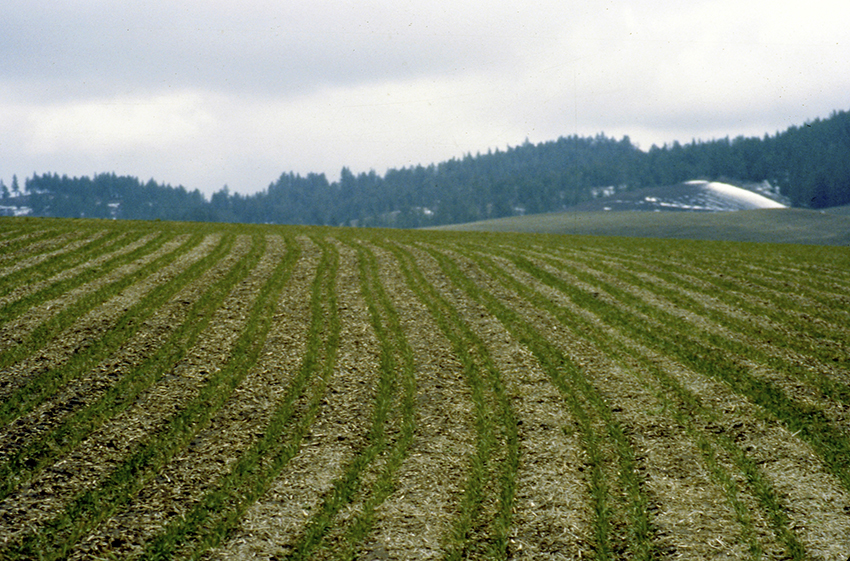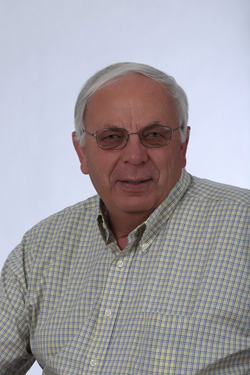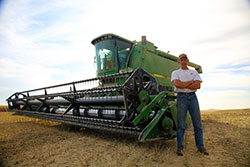|

Return To Main Page
See all our previous broadcasts
Not True?
Agriculture takes a 321 year leap ahead with placement of
fertilizer....
Yes Sir, 321 years
later....What did Squire Jethro Tull know about drilling cereal
grains?
 1.
1.
What is the optimum spacing of a barley or wheat seed berry in a seed row?
Why is offset leading double disc superior in raising top yields?
In cereal grains what is the optimum spacing in a seed row?
 2.
2.
Joel McClure discovered that planting winter wheat with a 20 inch planter
with wheat seed metering discs produced good yields as compared to 10 inch
spacing at half rates and planting twice.
Planters have distinct advantages when planting on 20 inch…it is the tool
of choice for winter wheat. SRS can also be used in irregular soil
moisture conditions.
The
hybrid Corn seed is expensive and must be accurately spaced to allow roots
to develop rapidly and light to be absorbed efficiently on 30 inch row
spacing to 20 inch row spacing.
Small
grains like winter wheat and brewing barley are spaced a lot differently
to use water and light more effectively.
Breeders know why seed must be properly spaced. Barley breeders are
especially aware of seed spacing. Simulating the barley or wheat head
spacing in a tight row is optimized spacing and seeding rate. Soldiers in
a closed rank line and marching off to war.
Jethro
Tull (1674
– 21 February 1741, New
Style) was an English agricultural pioneer from Berkshire who
helped bring about the British
Agricultural Revolution. He perfected a horse-drawn  seed
drill in 1700 that economically sowed the seeds in neat rows. He later
developed a horse-drawn hoe.
Tull's methods were adopted by many great landowners and helped to provide
the basis for modern agriculture. seed
drill in 1700 that economically sowed the seeds in neat rows. He later
developed a horse-drawn hoe.
Tull's methods were adopted by many great landowners and helped to provide
the basis for modern agriculture.
Circa 1731 Tull's
book upon husbandry also influenced cotton
culture in the American Southern Colonies. Tull's system taught
that to ensure a sufficient number of plants, they did not just need to
increase the quantity of seed, but to plant the seed at regular distances.
The Seed
Drill
Jethro Tull invented the seed drill in 1701 as a way to plant more
efficiently. Prior to his invention, sowing seeds was done by hand, by
scattering them on the ground or placing them in the ground individually,
such as with bean and pea seeds. Tull considered scattering wasteful,
because many seeds did not take root.
His
finished seed drill included a hopper to store the seed, a cylinder to
move it, and a funnel to direct it. A plow at the front created the row,
and a harrow at the back covered the seed with soil. It was the first
agricultural machine with moving parts. It started as a one-man, one-row
device, but later designs sowed seeds in three uniform rows, had wheels,
and were drawn by horses. Using wider spacing than previous practices
allowed horses to draw the equipment 3. and not step on
the plants.
 4.
4.
Your seeding questions have simple answers. ….study the spacing of the
barley seed in the head.
-
Thus the in-row seed spacing is correct if it is between .45 inches to
.625 inches apart depending on the seed size in a tight soil vee design.
-
This in row seed spacing forces the seminal roots to initial compete
strongly and reach for moisture.
-
The seed spacing forces the coleoptiles to push to the surface. A push
of 1.25 to 2 inches with good turgor pressure from ample soil moisture.
-
The seed is surrounded by soil that provides osmotic movement of
moisture into the seed berry. Soil cracking and air pockets must be
avoided.
-
From 1701 to 2021 the story is the same, we march together in tight
closed rank and drive the seminal roots deep and coleoptiles toward the
sun as fast as possible.
A review of Paired
Row and why Yielder Drills consistently yield 20% to 30% higher in winter
wheat.
A review of Paired
Row and why Yielder Drills consistently yield 20% to 30% higher in winter
wheat.
 5.
5.
Number 1, It takes a good sprayer with low compaction and coverage.
Coverage is the key word.
Eating acres in step Palouse Hills.
An acre goes fast at165 feet at 4 to 6 mph (8V-71) with a steady boom,
three pumps, pressure compensation, an Aircraft Gyro Compass and a Harley
out-rider.
 6.
6.
A sprayer that can cover all acres in wet, snowy conditions.
Tough going, whereby and when other machines can not go.
Superior weed control in late fall and early, wet spring conditions.
 7. 7.
A 2020 Yielder
Paired Row 5/15 (left) outyields mid row banding of a 2020 Yielder 10 inch
spacing at the same fertilizer rate.
Paired Row Yield Punch is 10% or 12.6 more bushels per acre in Palouse
conditions.
In this case with Stephens, Soft White Winter Wheat, Don Quist, Pullman,
Washington/Moscow, Idaho.
 8.
8.
Leveraged Fertility Drives the producers to change. The row
spacing
is changed to 5/15.
The plant root system gets full
seminal root access to placed nutrients,
By 1980
Fertilizer Placement arrived. Banding fertilizer with double disc openers
between rows hides the fertilizer from the weeds.
Feed the growing
crop with leveraged fertility and starve the weeds.
Another leap ahead with winter annual Dwarf Essex, Yielder Drills with
high capacity allowed Dwarf Essex Winter Rape to be seeded with Water
Injection or SRS.
Paired Row Seedings on 5/15 inch or average 10 inch allowed
water to be injected in the seed row to establish Dwarf Essex in 1984. A
technology that is applicable today.
 9.
9.
The Floating Tool with 24 inch banding and seeding openers.
Each tool bar
weighs 1,100 lbs. Each tool bar is typically in a different plane
position adjusting for roll, pitch and yaw.
The tool bar follows the changing terrain and maintains the correct slope
angle interface for seed placement.
The seed release is controlled into tight V Slots. Osmotic movement to the
seed is now enhanced.
The seed is held by the 24 inch blades releasing all the seed to the
bottom of the V slot.
A means to germinate all seeds timely and together. This produces vigor in
the young plant by marching into war together.
The geometric force of the seeds competing for moisture and light as the
team is aligned for survival.
 10. 10.
Paired rows drive
nutrient efficiency.
A Yielder drill
seems to be the only machine that can meter seed with the openers on 5/15
spacing.
“Where
the rubber meets the road “
or right at the opener ground line in steep rolling conditions requiring
lots of horsepower.
The challenge is to
align seed rows at proper seeding depth and within the boundaries of the
NPKS deep band located at about 5 inches
in depth and 2.5
inches to the side of the seed row.
Anhydrous Ammonia is
the key nutrient
which makes this system in fall and spring conditions,
secondarily Aqua Ammonia,
Ammonia is
stable and the most
crop available form of nitrogen.
Only
Anhydrous ammonia becomes part of the soil.
-
Fall or Spring
applied NH4 is connected to Carbohydrates,C-6,H-12,O-6 and introduced
polymers which pulls the most moisture from the soil because it is part
of the soil and non-mobile.
-
Other types of
nitrogen are either not crop available (Urea) or are connect to the
water (32-0-0, 28-0-0),
-
These second and
third tier nitrogen sources are part of the water or the wetting front
as water perks into the soil.
-
These third tier
nitrate type materials (32-0-0, 28-0-0,) are negative valence allowing
nutrient mobility beyond the root zone.
-
Only Anhydrous
Ammonia and Snow go together Hand and Glove.
-
Just like peas
and carrots ammonia is naturally part of the soil when uniformly
applied.
 11. 11.
Paired Row 5/15
Yielder Seeding, model 2020, Spring of 1983. The Breakout of Paired Row.
Soldiers marching together.
-
As the snow is
leaving the Stephens Winter Wheat crop breaks dormancy and starts faster
with phosphate formulated into a deep band of NPKS and Micros.
-
Winter annuals
are controlled in the fall and with leverage fertility of Paired Row.
-
The fertilizer is
trapped by the growing crop whereby the weeds are starved.
-
Soil Heaving and
thawing in the early spring is avoided in No-till.
-
The soil is
thermally uniform due to no-tillage and residue on top of the deck.
-
The Cercosporella
foot rot or eyespot is avoided.
-
No dangerous
mercury based chemicals are required to control a yield robbing, root
invasion fungus.
-
Top dressing,
spring or fall, of fertilizer is never used in Yielder Paired Row
systems when NPKS is banded between the seed rows.
-
Anhydrous Ammonia
and Snow go together hand and glove.
-
It takes a good
sprayer that can go late in the fall.
-
The key is a
Yielder drill with hidden technology that can carry out the practice of
Paired row with metered seed tied to the band of Anhydrous Ammonia.
Your
Great Plains Reporter.

Guy J Swanson.
|















